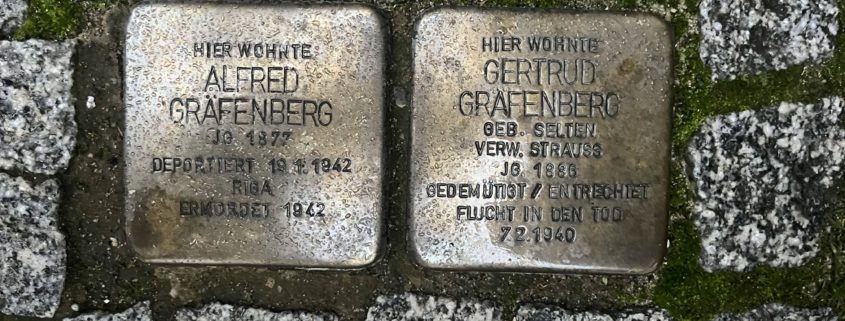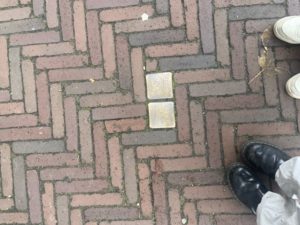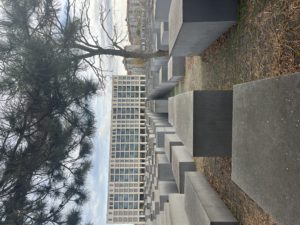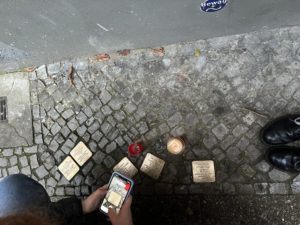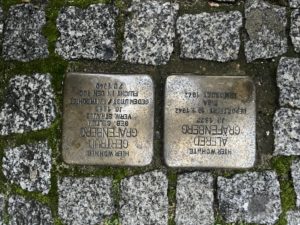Memorials Made Visible: School Curriculums as Essential to Memory Work
By Sofia DaCruz
Walking through the streets of Amsterdam with my friend Emma I admired the rows of houses lined along canals, and the leaves covering the streets. As I brushed the leaves while I walked, I noticed a glimmer of brass which I recognized as a Stolperstein or “stumbling stone”. Together we bent down to read the small blocks that stated the names, birthdays, deportation dates, and dates/places of murder of Jews who once lived in the homes in front of which the stone lies. Emma, who has lived in Amsterdam for three years and walked this route many times throughout those years, had never noticed the memorials that lie beneath her feet. Had they never been deliberately made visible to me through the Central Europe Program, I doubt I would have noticed them either. Robert Musil describes memorials as “conspicuously inconspicuous,” which captures this phenomenon of passing memorials every day, never noticing them or questioning their meaning (2006, p. 61). Stolpersteine in particular, are easily inconspicuous, as they are small and placed in the ground. But are imposing, seemingly unavoidable monuments necessarily more visible?
In the center of Berlin, surrounded by both historic and current government buildings, the Memorial to the Murdered Jews of Europe feels impossible to ignore. The monument covers the equivalent of a city block, with almost three thousand large blocks of concrete standing at various heights on uneven ground. When I first entered the memorial, I stood taller than the stones around me, but as I walked, I was quickly enveloped in the maze of towering slabs which grew taller with every step I took. I quickly lost those who I entered with, feeling consumed by a sense of loneliness among a bustling city. As I walked, I scoured each stone for some engraving: a name? a date? a place? I searched for something that felt similar to the Holocaust memorials I have seen which are typically filled with images, words, and stories. As I navigated out of the maze of stones, I thought of words my friend and classmate, Abby Wright, had asked after a visit to a museum in Banska Bystrica: “Can you have empathy without a story?” she asked. In my search for a story, I hoped to feel emotionally moved, even brought to tears as I have in other memorials that have projected a more literal representation of the Holocaust. I began to consider that the sense of loneliness, isolation, confusion, and fear I felt was meant to reflect the Jewish experience during the Holocaust. The story that I “found,” or created, and the empathy that came with it emerged from my prior knowledge about the events. My education had prepared me to interpret meaning from the seemingly storyless monument. Could someone who didn’t have the Holocaust education that I have had find meaning in this memorial? I posed this question to Josi, our guide, who was born in and has spent much of her life in Berlin. She described how in her schooling she was taken to this memorial as a part of learning about the mass atrocities of WWII. What both mine and Josi’s experiences point to, is the importance of a relationship between education and memorials. It is through education, both Josi’s in Berlin and mine studying abroad, that this monument’s meaning was made conspicuous. Without education, the Monument to the Murdered Jews of Europe could become invisible, still able to be literally seen, but without meaning.
Counter to the Monument to the Murdered Jews of Europe, the Stolpersteine are small, decentralized, and focused on individual names and experiences. Walking around Berlin, they were particularly noticeable because of the candles surrounding them, placed in remembrance of Kristallnacht, or the November Pogroms of 1938. The presence of candles points to an active process of remembering. The stones are not placed and then left, but recognized yearly, by residents and neighbors. While this annual recognition shows an understanding of the memorials’ meaning, it was also clear that the stones in Berlin had been worn and trodden on. The bronze was not shiny, and the engravings were worn down. Stolpersteine, by the nature of their size and location on the ground, can be made invisible when walked over without a thought. It is the active processes of education that makes them impossible to ignore. Learning in school about the history of the Holocaust, and maybe engaging in a research project where students investigate the names on Stolpersteine near their houses, are ways that education systems can serve as the source of conspicuousness. Education means more than a memorization of dates and facts, but an active engagement with the present and future. While schools are able to teach the past, it is important that they engage with memorials because memorials serve as a representation of the past in the present. This link is important because of its ability to create education about history that is not stuck in the past, but engaging with the present and future.
It is through my education that I notice Stolpersteine, bending down to read the name out loud on each stone that I encounter. It is Stolpersteine that force me to engage with the history of the Holocaust in the present, not allowing learning to be restricted solely to a classroom but brought into my everyday life. It is through my education that I found meaning in the Monument to the Murdered Jews of Europe, noticing how it reflected the orderly disorder of the Nazi regime. And yet, it is also the memorial itself that forced me to think more deeply about the emotions experienced by Jews during the Holocaust and also prompted me to consider the mechanisms of state violence. The relationship between formalized education and memorials is symbiotic. Memorials can often serve as education themselves, and yet they require formalized education integrated into school curriculums to be fully understood as representations of larger history. Curricula need to engage with these memorials, both teaching historical context and the critical thinking skills that allow citizens to learn from the memorials themselves. Otherwise, memorials become a means of forgetting, a way of saying “We acknowledged our history and now we are done.” The presence of a memorial is not enough. Education is the essential process in which memorials remain conspicuous and memorials are the way that history is brought into the everyday.
References
Musil, R. (2006). Monuments. In R. Musil & P. Wortsman (Authors), Posthumous Papers of a Living Author (pp. 61-64). Archipelago Books.

